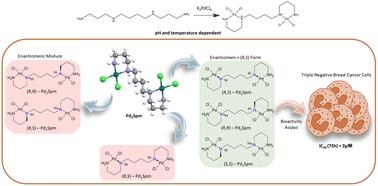钯(II)抗癌剂:pd -精胺复合物的复杂情况
IF 3.3
3区 化学
Q2 CHEMISTRY, INORGANIC & NUCLEAR
引用次数: 0
摘要
钯基抗癌药物是铂类药物的有希望的替代品,具有克服获得性耐药性和减少副作用的潜力。其中,双核Pd(II) -精胺复合物(Pd2Spm)在体外表现出显著的细胞抑制活性。但其合成机理和结构性质尚不清楚,阻碍了其进一步开发。本研究报告了Pd2Spm的优化合成路线,揭示了pH依赖性和温度诱导的异构体变化。这些变化通过振动光谱学进行了彻底的表征,从而确定了纯非对映体(R,S),对映体混合物((R,R)和(S,S))以及含有这三种异构体的混合物。在人三阴性乳腺癌MDA-MB-231细胞系中进行了非对映体和对映体和非对映体混合物的细胞活力测试,结果显示这些实体的结果相同(72 h时IC50分别为2.7 μM和2.6 μM)。这是一个优化的合成和抗癌体外测定明确的Pd2Spm结构的第一份报告。目前的研究结果加强了Pd2Spm作为下一代抗癌金属药物的潜力,为临床前试验铺平了道路。本文章由计算机程序翻译,如有差异,请以英文原文为准。

Palladium(II) anticancer agents: the intricate case of the Pd–spermine complex
Palladium-based anticancer drugs are promising alternatives to platinum agents, with potential to overcome acquired resistance and reduce side effects. Among them, the dinuclear Pd(II)–spermine complex (Pd2Spm) has shown notable cytostatic activity in vitro. However, its synthesis mechanism and structural properties remain poorly understood, which hinders further development. This study reports an optimised synthetic route for Pd2Spm, revealing pH dependence and temperature-induced isomeric changes. These variations were thoroughly characterised by vibrational spectroscopy, leading to the identification of the pure diastereomer (R,S), the enantiomeric mixture ((R,R) and (S,S)) and the mixture containing these three isomers. Cell viability tests were carried out in the human triple negative breast cancer MDA-MB-231 cell line for the diastereomer and the enantiomers and diastereomer mixture, demonstrating equivalent results for these entities (IC50 equal to 2.7 and 2.6 μM at 72 h, respectively). This is the first report of an optimised synthesis and anticancer in vitro assays for a well-defined Pd2Spm structure. The present findings strengthen the potential of Pd2Spm as a next-generation anticancer metallodrug, paving the way for preclinical trials.
求助全文
通过发布文献求助,成功后即可免费获取论文全文。
去求助
来源期刊

Dalton Transactions
化学-无机化学与核化学
CiteScore
6.60
自引率
7.50%
发文量
1832
审稿时长
1.5 months
期刊介绍:
Dalton Transactions is a journal for all areas of inorganic chemistry, which encompasses the organometallic, bioinorganic and materials chemistry of the elements, with applications including synthesis, catalysis, energy conversion/storage, electrical devices and medicine. Dalton Transactions welcomes high-quality, original submissions in all of these areas and more, where the advancement of knowledge in inorganic chemistry is significant.
 求助内容:
求助内容: 应助结果提醒方式:
应助结果提醒方式:


